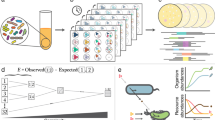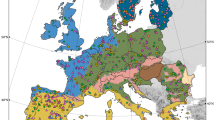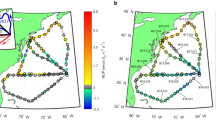Abstract
Microbial ecologists continue to seek a greater understanding of the factors that govern the ecological significance of microbial community structure. Changes in community structure have been shown to have functional significance for processes that are mediated by a narrow spectrum of organisms, such as nitrification and denitrification, but in some cases, functional redundancy in the community seems to buffer microbial ecosystem processes. The functional significance of microbial community structure is frequently obscured by environmental variation and is hard to detect in short-term experiments. We examine the functional significance of free-living diazotrophs in a replicated long-term tillage experiment in which extraneous variation is minimized and N-fixation rates can be related to soil characteristics and diazotroph community structure. Soil characteristics were found to be primarily impacted by tillage management, whereas N-fixation rates and diazotroph community structure were impacted by both biomass management practices and interactions between tillage and biomass management. The data suggest that the variation in diazotroph community structure has a greater impact on N-fixation rates than do soil characteristics at the site. N-fixation rates displayed a saturating response to increases in diazotroph community diversity. These results show that the changes in the community structure of free-living diazotrophs in soils can have ecological significance and suggest that this response is related to a change in community diversity.
Similar content being viewed by others
Log in or create a free account to read this content
Gain free access to this article, as well as selected content from this journal and more on nature.com
or
Accession codes
References
Alahari A, Apte SK . (1998). Pleiotropic effects of potassium deficiency in a heterocystous, nitrogen-fixing cyanobacterium, Anabaena torulosa. Microbiology-SGM 144: 1557–1563.
Azam F, Mahmood T, Malik KA . (1988). Immobilization-remineralization of NO3-N and total N balance during the decomposition of glucose, sucrose and cellulose in soil incubated at different moisture regimes. Plant Soil 107: 159–163.
Bothe H, Mergel A, Rosch C . (2002). Diversity of dinitrogen fixing and denitrifying bacteria in soils assessed by molecular biological methods. In: Finan TM, O’Brian MR, Layzell DB, Vessey JK, Newton W (ed). Nitrogen Fixation: Global Perspectives. CABI Publishing: New York. pp 305–308.
Brouzes R, Lasik J, Knowles R . (1969). Effect of Organic Amendment, Water Content, and Oxygen on Incorporation of 15N2 by Some Agricultural and Forest Soils. Can J Microbiol 15: 899–905.
Buckley DH, Huangyutitham V, Hsu S-F, Nelson TA . (2007). Stable Isotope Probing with 15N2 reveals novel non-cultivated diazotrophs in soil. Appl Environ Microbiol 73: 3196–3204.
Buckley DH, Schmidt TM . (2001). The structure of microbial communities in soil and the lasting impacts of cultivation. Microb Ecol 42: 11–21.
Buckley DH, Schmidt TM . (2003). Diversity and dynamics of microbial communities in soils from agroecosystems. Environ Microbiol 5: 441–452.
Burgmann H, Meier S, Bunge M, Widmer F, Zeyer J . (2005). Effects of model root exudates on structure and activity of a soil diazotroph community. Environ Microbiol 7: 1711–1724.
Burgmann H, Widmer F, Von Sigler W, Zeyer J . (2004). New molecular screening tools for analysis of free-living diazotrophs in soil. Appl Environ Microbiol 70: 240–247.
Burt R . (2004). Soil Survey Laboratory Methods Manual Version 4 ed. vol. Soil Survey Investigations Report No. 42. National Resources Conservation Service.
Carney KM, Matson PA, Bohannan BJM . (2004). Diversity and composition of tropical soil nitrifiers across a plant diversity gradient and among land-use types. Ecology Lett 7: 684–694.
Cavigelli MA, Robertson GP . (2000). The functional significance of denitrifier community composition in a terrestrial ecosystem. Ecology 81: 1402–1414.
Chotte JL, Schwartzmann A, Bally R, Monrozier LJ . (2002). Changes in bacterial communities and Azospirillum diversity in soil fractions of a tropical soil under 3 or 19 years of natural fallow. Soil Biol Biochem 34: 1083–1092.
Cleveland CC, Townsend AR, Schimel DS, Fisher H, Howarth RW, Hedin LO et al. (1999). Global patterns of terrestrial biological nitrogen (N-2) fixation in natural ecosystems. Global Biogeochem Cy 13: 623–645.
Deslippe JR, Egger KN, Henry GHR . (2005). Impacts of warming and fertilization on nitrogen-fixing microbial communities in the Canadian High Arctic. FEMS Microbiol Ecol 53: 41–50.
Felsenstein J . (2005). PHYLIP (Phylogeny Inference Package), v3.64. University of Washington, Department of Genome Sciences: Seattle.
Finn RD, Mistry J, Schuster-Böckler B, Griffiths-Jones S, Hollich V, Lassmann T et al. (2006). Pfam: clans, web tools and services. Nucleic Acids Res 34: D247–D251.
Gulledge J, Doyle AP, Schimel JP . (1997). Different NH4+ inhibition patterns of soil CH4 consumption: a result of distinct CH4 oxidizer populations across sites? Soil Biol Biochem 29: 13–21.
Gupta V, Roper MM, Roget DK . (2006). Potential for non-symbiotic N-2-fixation in different agroecological zones of southern Australia. Aust J Soil Res 44: 343–354.
Hamelin J, Fromin N, Tarnawski S, Teyssier-Cuvelle S, Aragno M . (2002). nifH gene diversity in the bacterial community associated with the rhizosphere of Molinia coerulea, an oligonitrophilic perennial grass. Environ Microbiol 4: 477–481.
Hawkes CV, Wren IF, Herman DJ, Firestone MK . (2005). Plant invasion alters nitrogen cycling by modifying the soil nitrifying community. Ecology Lett 8: 976–985.
Hooper DU, Chapin FS, Ewel JJ, Hector A, Inchausti P, Lavorel S et al. (2005). Effects of biodiversity on ecosystem functioning: A consensus of current knowledge. Ecol Monogr 75: 3–35.
Hughes JB, Hellman JJ, Ricketts TH, Bohannan BJM . (2001). Counting the uncountable: statistical approaches to estimating microbial diversity. Appl Environ Microbiol 67: 4399–4406.
Izquierdo JA, Nusslein K . (2006). Distribution of extensive nifH gene diversity across physical soil microenvironments. Microb Ecol 51: 441–452.
Jensen BB, Cox RP . (1983). Direct measurements of steady-state kinetics of cyanobacterial N2 uptake by membrane-leak mass spectrometry and comparisons between nitrogen-fixation and acetylene reduction. Appl Environ Microbiol 45: 1331–1337.
Keeling AA, Cook JA, Wilcox A . (1998). Effects of carbohydrate application on diazotroph populations and nitrogen availability in grass swards established in garden waste compost. Bioresour Technol 66: 89–97.
Kondo M, Yasuda M . (2003a). Effects of temperature, water regime, light, and soil properties on N-15(2) fixation associated with decomposition of organic matter in paddy soils. Jpn Agric Res Q 37: 113–119.
Kondo M, Yasuda M . (2003b). Seasonal changes in N-2 fixation activity and N enrichment in paddy soils as affected by soil management in the northern area of Japan. Jpn Agric Res Q 37: 105–111.
Konstantinidis KT, Tiedje JM . (2005). Genomic insights that advance the species definition for prokaryotes. Proc Natl Acad Sci USA 102: 2567–2572.
Koteva ZV, Kudeyarov VN, Myakshina TN . (1992). Effect of nitrogen fertilizers and other factors on potential nitrogen-fixation and denitrification activity of Gray Forest soil. Eurasian Soil Sci 24: 1–11.
Liengen T . (1999). Conversion factor between acetylene reduction and nitrogen fixation in free-living cyanobacteria from high arctic habitats. Can J Microbiol 45: 223–229.
Limmer C, Drake HL . (1996). Non-symbiotic N-2-fixation in acidic and pH-neutral forest soils: Aerobic and anaerobic differentials. Soil Biol Biochem 28: 177–183.
Lozupone C, Knight R . (2005). UniFrac: a new phylogenetic method for comparing microbial communities. Appl Environ Microbiol 71: 8228–8235.
Magurran AE . (1988). Ecological diversity and its measurement. Princeton University Press: Princeton, NJ, pp 81–101.
Mergel A, Kloos K, Bothe H . (2001). Seasonal fluctuations in the population of denitrifying and N-2-fixing bacteria in an acid soil of a Norway spruce forest. Plant Soil 230: 145–160.
Moisander PH, Steppe TF, Hall NS, Kuparinen J, Paerl HW . (2003). Variability in nitrogen and phosphorus limitation for Baltic Sea phytoplankton during nitrogen-fixing cyanobacterial blooms. Mar Ecol Prog Ser 262: 81–95.
Montoya JP, Voss M, Kahler P, Capone DG . (1996). A simple, high-precision, high-sensitivity tracer assay for N-2 fixation. Appl Environ Microbiol 62: 986–993.
Nelson DR, Mele PM . (2006). The impact of crop residue amendments and lime on microbial community structure and nitrogen-fixing bacteria in the wheat rhizosphere. Aus J Soil Res 44: 319–329.
Nohrstedt HO . (1983). Conversion factor between acetylene reduction and nitrogen fixation in soil: effects of water content and nitrogenase activity. Soil Biol Biochem 15: 275–279.
Olsen GJ, Matsuda H, Hagstrom R, Overbeek R . (1994). FasDNAml: a tool for construction of phylogenetic trees of DNA sequences using maximum likelihood. Comput Appl Biosci 10: 41–48.
O’Toole P, Knowles R . (1973). Efficiency of acetylene reduction (nitrogen fixation) in soil: effect of type and concentration of available carbohydrate. Soil Biol Biochem 5: 789–797.
Patra AK, Abbadie L, Clays-Josserand A, Degrange V, Grayston SJ, Guillaumaud N et al. (2006). Effects of management regime and plant species on the enzyme activity and genetic structure of N-fixing, denitrifying and nitrifying bacterial communities in grassland soils. Environ Microbiol 8: 1005–1016.
Piceno YM, Lovell CR . (2000). Stability in natural bacterial communities: I. Nutrient addition effects on rhizosphere diazotroph assemblage composition. Microb Ecol 39: 32–40.
Poly F, Ranjard L, Nazaret S, Gourbiere F, Monrozier LJ . (2001). Comparison of nifH gene pools in soils and soil microenvironments with contrasting properties. Appl Environ Microbiol 67: 2255–2262.
Reed HE, Martiny JBH . (2007). Testing the functional significance of microbial composition in natural communities. FEMS Microbiol Ecol 62: 161–170.
Roesch LFW, Camargo FAO, Bento FM, Triplett EW . (2008). Biodiversity of diazotrophic bacteria within the soil, root and stem of field-grown maize. Plant Soil 302: 91–104.
Roper MM . (1983). Field-Measurements of Nitrogenase Activity in Soils Amended with Wheat Straw. Aust J Agric Res 34: 725–739.
Roper MM, Marschke GW, Smith NA . (1989). Nitrogenase Activity (C2h2 Reduction) in Soils Following Wheat Straw Retention - Effects of Straw Management. Aust J Agric Res 40: 241–253.
Roper MM, Smith NA . (1991). Straw decomposition and nitrogenase activity (C2H2 Reduction) by free-living microorganisms from soil - effects of pH and clay content. Soil Biol Biochem 23: 275–283.
Roper MM, Turpin JE, Thompson JP . (1994). Nitrogenase activity (C2h2 Reduction) by free-living bacteria in soil in a long-term tillage and stubble management experiment on a vertisol. Soil Biol Biochem 26: 1087–1091.
Schimel J . (1995). Ecosystem consequences of microbial diversity and community structure. In: Chapin FS, Korner C (ed). Artic and Alpine Diversity: Patterns, Causes, and Ecosystem Consequences. Springer: New York, pp 241–254.
Schloss PD, Handelsman J . (2005). Introducing DOTUR, a computer program for defining operational taxonomic units and estimating species richness. Appl Environ Microbiol 71: 1501–1506.
Schloss PD, Handelsman J . (2008). A statistical toolbox for metagenomics: assessing functional diversity in microbial communities. BMC Bioinformatics 9: 34.
Schloss PD, Larget BR, Handelsman J . (2004). Integration of microbial ecology and statistics: a test to compare gene libraries. Appl Environ Microbiol 70: 5485–5492.
Shaffer BT, Widmer F, Porteous LA, Seidler RJ . (2000). Temporal and spatial distribution of the nifH gene of N2 fixing bacteria in forests and clearcuts in western Oregon. Microb Ecol 39: 12–21.
Sindhu SS, Grover V, Narula N, Lakshminarayana K . (1989). Occurrence of multiple antibiotic-resistance in Azotobacter-Chroococcum. Zentralblatt Fur Mikrobiologie 144: 97–101.
Skujins J, Tann CC, Borjesson I . (1987). Dinitrogen fixation in a montane forest sere determined by 15N2 assimilation and in situ acetylene-reduction methods. Soil Biol Biochem 19: 465–471.
Spiff ED . (1973). Non-symbiotic nitrogen fixation in latosols derived from sedimentary and basement complex rocks. J West Afr Sci Assoc 18: 177–186.
Steward GF, Jenkins BD, Ward BB, Zehr JP . (2004). Development and testing of a DNA microarray to assess nitrogenase (nifH) gene diversity. Appl Environ Microbiol 70: 1455.
Stewart WPD, Fitzgerald GP, Harris RH . (1967). In situ studies on nitrogen fixation using acetylene-reduction technique. Proc Natl Acad Sci USA 58: 2071–2078.
Strunk O, Ludwig W . (1997). ARB: a software environment for sequence data, v2.5. Department of Microbiology, Technical University of Munich: Munich, Germany.
Swofford DL . (1991). PAUP: phylogenetic analysis using parsimony, v3.1. Illinois Natural History Survey: Champaign.
Symstad AJ, Chapin FS, Wall DH, Gross KL, Huenneke LF, Mittelbach GG et al. (2003). Long-term and large-scale perspectives on the relationship between biodiversity and ecosystem functioning. Bioscience 53: 89–98.
Tan XY, Hurek T, Reinhold-Hurek B . (2003). Effect of N-fertilization, plant genotype and environmental conditions on nifH gene pools in roots of rice. Environ Microbiol 5: 1009–1015.
Ueda T, Suga Y, Yahiro N, Matsuguchi T . (1995). Remarkable N-2-fixing bacterial diversity detected in rice roots by molecular evolutionary analysis of nifH gene-sequences. J Bacteriol 177: 1414–1417.
Vitousek PM, Hobbie S . (2000). Heterotrophic nitrogen fixation in decomposing litter: Patterns and regulation. Ecology 81: 2366–2376.
Wakelin SA, Colloff MJ, Harvey PR, Marschner P, Gregg AL, Rogers SL . (2007). The effects of stubble retention and nitrogen application on soil microbial community structure and functional gene abundance under irrigated maize. FEMS Microbiol Ecol 59: 661–670.
Webster G, Embley TM, Freitag TE, Smith Z, Prosser JI . (2005). Links between ammonia oxidizer species composition, functional diversity and nitrification kinetics in grassland soils. Environ Microbiol 7: 676–684.
Widmer F, Shaffer BT, Porteous LA, Seidler RJ . (1999). Analysis of nifH gene pool complexity in soil and litter at a Douglas fir forest site in the Oregon Cascade Mountain Range. Appl Environ Microbiol 65: 374–380.
Wohl DL, Arora S, Gladstone JR . (2004). Functional redundancy supports biodiversity and ecosystem function in a closed and constant environment. Ecology 85: 1534–1540.
Yeager CM, Northup DE, Grow CC, Barns SM, Kuske CR . (2005). Changes in nitrogen-fixing and ammonia-oxidizing bacterial communities in soil of a mixed conifer forest after wildfire. Appl Environ Microbiol 71: 2713–2722.
Zechmeister-Boltenstern S, Kinzel H . (1990). Non-symbiotic nitrogen fixation associated with temperate soils in relation to soil properties and vegetation. Soil Biol Biochem 22: 1075–1084.
Zhang YG, Li DQ, Wang HM, Xiao QM, Liu XD . (2006). Molecular diversity of nitrogen-fixing bacteria from the Tibetan Plateau, China. FEMS Microbiol Lett 260: 134–142.
Acknowledgements
This research was supported by the National Science Foundation Award, number MCB-0447586. This research was also supported in part by the National Research Initiative of the USDA Cooperative State Research, Education and Extension Service, Grant number 2005-35107-15266.
Author information
Authors and Affiliations
Corresponding author
Rights and permissions
About this article
Cite this article
Hsu, SF., Buckley, D. Evidence for the functional significance of diazotroph community structure in soil. ISME J 3, 124–136 (2009). https://doi.org/10.1038/ismej.2008.82
Received:
Revised:
Accepted:
Published:
Issue date:
DOI: https://doi.org/10.1038/ismej.2008.82
Keywords
This article is cited by
-
Conifer and broadleaf trees show a strong co-evolution with rhizosphere diazotrophic microbiome
Plant and Soil (2023)
-
Microbial controls on symbiotic and free-living N2 fixation in subtropical Pueraria lobata communities, southwest China
Biogeochemistry (2023)
-
A positive response of ginger root zone and rhizome development to suitable sowing depth
Protoplasma (2022)
-
Biological nitrogen fixation and nifH gene abundance in deadwood of 13 different tree species
Biogeochemistry (2022)
-
Long-term straw return increases biological nitrogen fixation by increasing soil organic carbon and decreasing available nitrogen in rice–rape rotation
Plant and Soil (2022)



